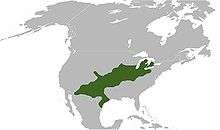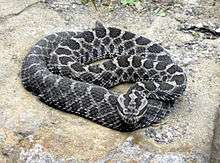Massasauga
The massasauga (Sistrurus catenatus) is a rattlesnake species found in midwestern North America from southern Ontario to northern Mexico and parts of the United States in between. Three subspecies are currently recognized including the nominate subspecies described here.[3] Like all rattlesnakes, it is a pit viper, and like all pit vipers, it is venomous.
| Massasauga | |
|---|---|
 | |
| Scientific classification | |
| Kingdom: | Animalia |
| Phylum: | Chordata |
| Class: | Reptilia |
| Order: | Squamata |
| Suborder: | Serpentes |
| Family: | Viperidae |
| Genus: | Sistrurus |
| Species: | S. catenatus |
| Binomial name | |
| Sistrurus catenatus (Rafinesque, 1818) | |
| Subspecies | |
|
3 subspecies, see text | |
 | |
| Synonyms[2] | |
| |
Description

Adults of S. catenatus are not large, ranging from 60 to 75 cm (24 to 30 in) in length.[4] The color pattern consists of a grey or tan ground color with a row of large rounded brown/black blotches or spots down the center of the back and three smaller rows of alternating spots down each side. Solid black melanistic examples are also known, as well as cases where the back blotches join with those on the sides. Young massasauga are well-patterned but paler than the adults. It has heat-sensing pits on each side of its smallish head, the scales are keeled, and the anal scale is single.
Common names
Common names of the massasauga include: massasauga rattlesnake, massasauga rattler (Ontario), black massasauga, black rattler, black snapper, gray rattlesnake (Iowa), little grey rattlesnake (Canada), muck rattler, prairie rattlesnake, spotted rattler, swamp rattler, víbora de cascabel (Mexico), dwarf prairie rattlesnake, eastern massasauga great adder, ground rattlesnake, Kirtland's rattlesnake, little black rattlesnake, Michigan point rattler (Michigan), prairie massasauga, rattlesnake, small prairie rattlesnake, snapper, swamp massasauga, swamp rattlesnake, and triple-spotted rattlesnake.[5][6]
The Native American word, "massasauga", means "great river-mouth" in the Ojibwe language and was probably given to describe grasslands surrounding the river deltas in Ojibwe country.[7]
Geographic range
S. catenatus is found in North America from Ontario, Canada and western New York southwest to southeastern Arizona in the United States and northern Tamaulipas, Mexico. In Mexico, isolated populations exist in southern Nuevo León, north-central Coahuila, and Samalayuca, Chihuahua.[8] It occurs in various habitats ranging from swamps and marshes to grasslands, usually below 1500 m elevation. The type locality given is "... on the prairies of the upper Missouri" (Valley, USA).[2]
According to Campbell and Lamar (2004), a population also exists in southeastern Colorado that is morphologically somewhat intermediate between S. c. tergeminus and S. c. edwardsii.[5]
Conservation status
The species S. catenatus is classified as least concern (LC) on the IUCN Red List of Threatened Species. Species are listed as such due to their wide distribution, presumed large population, or because they are unlikely to be declining fast enough to qualify for listing in a more threatened category. The population trend is unknown.[1] The eastern massasauga has been listed as a candidate species on the United States Endangered Species Act since 1999.[9]
The eastern massasauga is listed as an endangered species in Illinois, Indiana, Iowa, Minnesota, Missouri (also considered extirpated), New York, Ohio, Pennsylvania, and Wisconsin.[10][11][12] Michigan, the only state in which it is not considered endangered, lists it as "special concern".[13] The subspecies is a candidate for federal listing.[14] As of 2016, the massasauga is listed as Threatened under the Endangered Species Act.[15]
The massasauga is listed as threatened under both Ontario's Endangered Species Act, 2007, and the federal Species at Risk Act, and is protected under the Fish and Wildlife Conservation Act.[4][16] It is found only near the eastern shore of Georgian Bay, the Bruce Peninsula, the North Shore of Lake Huron,[17] Wainfleet Bog, and Ojibway Prairie.[18] It is becoming rare in Canada due to persecution and loss of habitat and is designated as "threatened" by the Committee on the Status of Endangered Wildlife in Canada (COSEWIC),[19] as well as the Committee on the Status of Species-at-risk in Ontario (COSSARO).
In Pennsylvania, the species has experienced a rapid decline largely because of habitat loss. Historically, this has been due to human activity and more recently primarily from natural forest succession. By 1988, the snake had disappeared from half of the counties that constituted its historical range.[20] A 2003–2005 survey showed only four locations in two counties with confirmed populations.[21] It is classified as "critically imperiled" to "imperiled" in the commonwealth.[22]
Diet
The diet of S. catenatus consists of a variety of small vertebrates, including mammals, lizards, and other snakes, as well as invertebrates such as centipedes. Mammals and reptiles make up the bulk of their diet. Adults feed mainly on rodents, while juveniles usually prey on reptiles, more often lizards in western populations and snakes in eastern ones. Frogs also constitute an important part of their diet: Ruthven (1928) mentioned that in Michigan they made up the main portion of their diet. According to Klauber (1956), S. catenatus feeds on frogs more frequently than any other rattlesnake. In general, however, frogs are not an important part of the diet, although this does seem to be more typical in certain northern and eastern populations.[5]
Venom
The venom of S. c. catenatus is a cytotoxic venom that destroys tissue. It also contains specialized digestive enzymes that disrupt blood flow and prevent blood clotting. Severe internal bleeding causes the death of the small animals that this snake eats. After envenomation, the rattlesnake is able to withdraw from the dangers of sharp-toothed prey animals until they are subdued and even partially digested by the action of the venom.
S. c. catenatus is rather shy and avoids humans when it can. Most massasauga snakebites in Ontario have occurred after people deliberately handled or accidentally stepped on one of these animals. Both of these scenarios can be prevented by avoiding hiking through areas of low visibility (in rattlesnake country) when not wearing shoes and long pants and by leaving the snakes alone if encountered. Only two incidents of people dying from massasauga rattlesnake bites in Ontario have been recorded; in both cases, the victims did not receive proper treatment.[23] Recent studies indicate that Ontario hospitals in rattlesnake country often do not have antivenom, as massasauga-specific antivenom is not easy to acquire.[24]
Subspecies
| Subspecies[3] | Taxon author[3] | Common name[25] | Geographic range[5][6][25] |
|---|---|---|---|
| Sistrurus catenatus catenatus (S. c. catenatus) | (Rafinesque, 1818) | Eastern massasauga | United States: central and western New York south of Lake Ontario, western Pennsylvania, northern and central Ohio, northern Indiana, lower Michigan, Illinois, southern and southwestern Wisconsin, extreme southeastern Minnesota, eastern Iowa, and northeastern Missouri
Canada: southern Ontario along the shores of Georgian Bay, Lake Huron, and Lake Erie Considered to be its own separate species as of 2011.[26] |
| Sistrurus catenatus edwardsii (S. c. edwardsii) | (Baird & Girard, 1853) | Desert massasauga | United States: extreme southeastern Arizona; central and southern New Mexico; western Texas about as far north and east as the Colorado River; the Rio Grande Valley; and throughout the Texas Gulf Coast region extending as far north as Brazoria County as well as on several barrier islands including North Padre Island, Matagorda Island, and San José Island
Mexico: isolated populations in the country's northeast region bordering Texas |
| Sistrurus catenatus tergeminus (S. c. tergeminus) | (Say, 1823) | Western massasauga | United States: extreme southeastern Nebraska and northwestern Missouri, east-central Kansas, west-central Oklahoma, and northern and central Texas about as far southwest as the Colorado River |
References
- Frost, D.R.; Hammerson, G.A. & Santos-Barrera, G. (2007). "Sistrurus catenatus". IUCN Red List of Threatened Species. 2007: e.T64346A12772707. doi:10.2305/IUCN.UK.2007.RLTS.T64346A12772707.en.
- McDiarmid RW, Campbell JA, Touré T. (1999). Snake Species of the World: A Taxonomic and Geographic Reference, vol. 1. Herpetologists' League. 511 pp. ISBN 1-893777-00-6 (series). ISBN 1-893777-01-4 (volume).
- "Sistrurus catenatus". Integrated Taxonomic Information System. Retrieved 30 January 2007.
- Eastern Massasauga, Ontario Nature
- Campbell JA, Lamar WW. (2004). The Venomous Reptiles of the Western Hemisphere. Comstock Publishing Associates, Ithaca and London. 870 pp. 1500 plates. ISBN 0-8014-4141-2.
- Wright AH, Wright AA. (1957). Handbook of Snakes of the United States and Canada. Comstock Publishing Associates. (7th printing, 1985). 1105 pp. ISBN 0-8014-0463-0.
- Behler JL, King FW. (1979). The Audubon Society Field Guide to North American Reptiles and Amphibians. New York: Alfred A. Knopf. 743 pp. LCCCN 79-2217. ISBN 0-394-50824-6. (Sistrurus catenatus, pp. 696-697 + Plates 632-633, 638.)
- Report on Samalayuca Fauna Reporte de Fauna de la Region de Samalayuca UACJ Archived 2006-12-01 at the Wayback Machine
- Moore, Jennifer; Gillingham, James (2006). "Spatial Ecology and Multi-scale Habitat Selection by a Threatened Rattlesnake: The Eastern Massasauga (Sistrurus catenatus catenatus)". Copeia. 2006: 742–751. doi:10.1643/0045-8511(2006)6[742:seamhs]2.0.co;2.
- "Illinois Natural History Survey Collections".
- Indiana Legislative Services Agency (2011), "312 IAC 9-5-4: Endangered species of reptiles and amphibians", Indiana Administrative Code, retrieved 28 Apr 2012
- "Stockdale, December 21, 2014".
- "Sustaining a Ssssssspecies" (Video). Michigan State University. June 16, 2016. Retrieved June 16, 2016.
- "The massasauga is listed as a special concern in the U.S. state of Michigan". michigan.gov. Retrieved 28 May 2012.
- "Eastern Massasauga Fact Sheet". U.S. Fish & Wildlife Service.
- Royal Ontario Museum: Massasauga Rattlesnake
- "Rattler makes rare appearance - on golf course".
- Rouse, J.D. and Wilson, R.J. (2001). Update COSEWIC Status Report on the Eastern Massasauga, Sistrurus catenatus catenatus. Prepared for the Committee of the Status of Endangered Wildlife in Canada (COSEWIC), November 2001. v+18pp.
- "Massasauga". Species at Risk. Canada. Retrieved June 16, 2016.
- Howard K. Reinert and Lauretta M. Bushar, "The Massasauga Rattlesnake in Pennsylvania: Continuing Habitat Loss and Population Isolation", International Symposium and Workshop on the Conservation of the Eastern Massasauga Rattlesnake, Sistrurus catenatus catenatus, 1992 May 8–9 May, Toronto Zoo, Toronto, Ontario.
- "Western Pennsylvania Conservancy - Eastern Massasauga Research".
- "Eastern Massasauga (Sistrurus catenatus catenatus)" Fact Sheet, Pennsylvania Natural Heritage Program
- "Eastern Masassauga Rattlesnake" (PDF). Retrieved June 16, 2016.
- Milne, Celia (August 11, 2009). "Anti-venom crisis in Ontario". Metro Canada. Retrieved June 16, 2016.
- Klauber LM. 1997. Rattlesnakes: Their Habitats, Life Histories, and Influence on Mankind. Second Edition. First published in 1956, 1972. University of California Press, Berkeley. ISBN 0-520-21056-5.
- Service, U.S. Fish and Wildlife. "USFWS: Eastern Massasauga".
- "Archived copy". Archived from the original on February 22, 2014. Retrieved February 10, 2014.CS1 maint: archived copy as title (link)
Further reading
- Ontario Snakes, Ontario Ministry of Natural Resources, Toronto, 1981. Pp. 36.
- Rafinesque, C.S. (1818). "Further Accounts of Discoveries in Natural History, in the Western States". American Monthly Magazine and Critical Review. 4 (5): 39–42. (Crotalinus catenatus, new species, p. 41).
External links
| Wikimedia Commons has media related to Massasauga. |
| Wikispecies has information related to Massasauga |
- Sistrurus at the Reptarium.cz Reptile Database. Accessed 15 September 2007.
- Massasauga at Encyclopædia Britannica. Accessed 22 June 2005.
- Eastern Massasauga at Learn Animals. Accessed 30 January 2007.
- Massasauga Rattlesnake on Reptiles and Amphibians of Iowa
